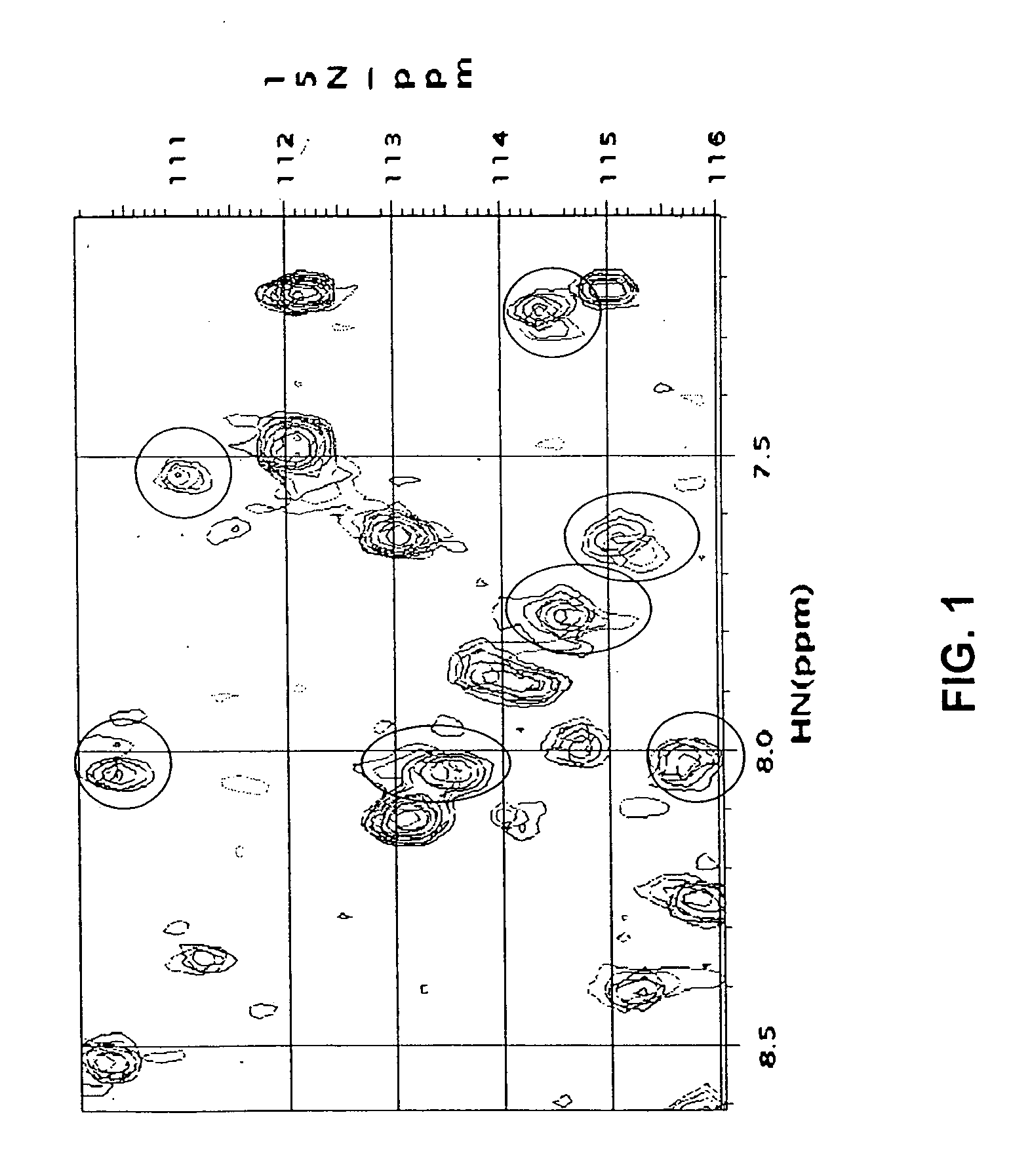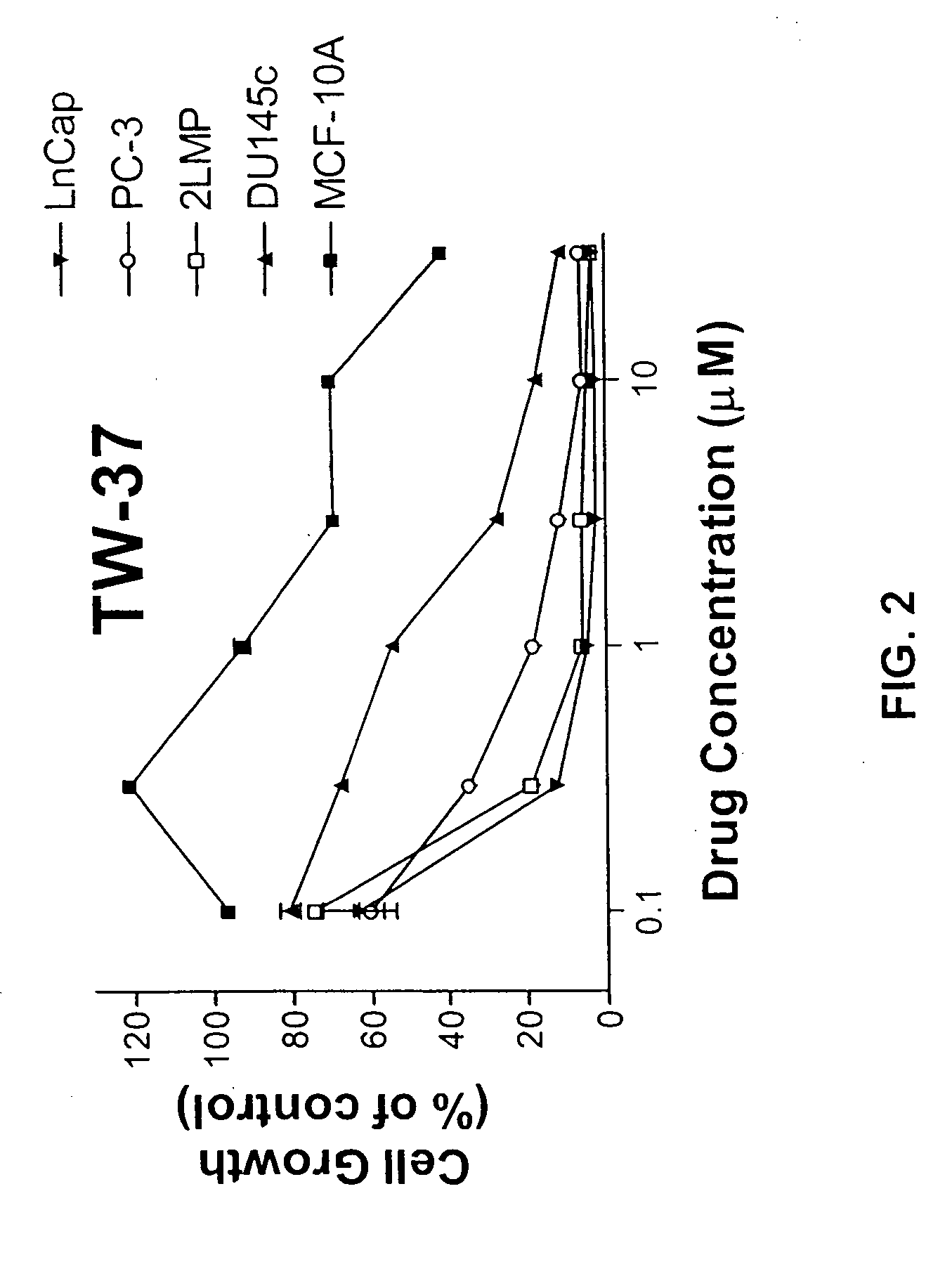Small molecule inhibitors of anti-apoptotic BCL-2 family members and the uses thereof
a small molecule inhibitor and anti-apoptotic technology, applied in the field of medicinal chemistry, to achieve the effect of less toxic, less toxic, and greater tumor response and clinical benefi
- Summary
- Abstract
- Description
- Claims
- Application Information
AI Technical Summary
Benefits of technology
Problems solved by technology
Method used
Image
Examples
example 1
Synthesis of Compounds of Formula I
[0117] General Methods: NMR spectra were acquired at a proton frequency of 300 MHz. 1H chemical shifts are reported with CD3COCD3 or CDCl3 as internal standards. 13C chemical shifts are reported with CD3COCD3 or CDCl3 as internal standards.
[0118] The following compounds (Tables 2-4) were synthesized and their structures analyzed by the general procedures described above.
TABLE 2NameCompoundTM-103TM-104TM-105TM-106TM-107TM-108TM-109TM-110TM-111TM-121TM-122TM-123TM-124TM-125TM-126TM-127TM-128TM-129TM-130TM-132TM-133TM-134TM-135TM-136TM-137TM-140TM-141TM-142TM-143TM-144TM-145TM-146TM-147TM-148TM-149TM-150TM-152TM-153TM-154TM-155TM-156TM-157TM-158TM-159TM-160TM-161TM-162TM-163TM-164TM-165TM-166TM-167TM-168TM-169TM-170TM-171TM-172TM-173TM-174TM-175TM-176TM-177TM-178TM-179TM-180TM-183TM-190TM-191TM-192TM-193TM-194TM-195TM-196TM-197TM-198TM-199TM-200 (1200)TM-1201TM-1202TM-1203TM-1205TM-1206TM-1207TM-1208TM-1209TM-1210TM-1211TM-1212TM-1213TM-1214TM-121...
example 2
Fluorescence Polarization Binding Assay
[0367] A 21-residue Bid BH3 peptide (QEDIIRNIARHLAQVGDSMDR) (SEQ ID NO:1) labeled at the N-terminus with 6-carboxyfluorescein succinimidyl ester (FAM) was used as the fluorescent tag (Flu-Bid-21). It was shown that this fluorescent peptide has high binding affinity with a Kd of 15.74 nM. Bcl-2 used in this assay is a recombinant His-fused soluble protein.
[0368] A 5 μl sample of the test compound dissolved in DMSO and preincubated Bcl-2 protein (0.120 μM) with Flu-Bid-21 peptide (0.010 μM) in assay buffer (100 mM potassium phosphate, pH 7.5; 100 μg / ml bovine gamma globulin; 0.02% sodium azide, purchased from Invitrogen Corporation, Life Technologies), are added in Dynex 96-well, black, round-bottom plates (Fisher Scientific) to produce a final volume of 125 μl. For each assay the bound peptide control containing Bcl-2 and Flu-Bid-21 peptide (equivalent to 0% inhibition), and free peptide control containing only fr...
example 3
Confirmation of TW-37 Binding to Bcl-2 by NMR
[0371] The binding of TW-37 to Bcl-2 was determined using 15N Heteronuclear Single Quantum Coherence Spectroscopy (HSQC) NMR methods.
[0372] The protein samples for NMR studies were uniformly labeled with 15N for screening and uniformly double labeled with 15N and 13C for structure characterization according to the methods described in M. Jansson et al., J. Biomol. NMR, 7:131-141 (1996), and M. L. Cai et al., J. Biomol. NMR, 11:97-102 (1998).
[0373] Since the NMR experiments were performed at pH 7.2 in a pulse field gradient (PFG), HSQC with water flip back was used to maximize signal intensity (S. Grzesiek and A. Bax, J. Am. Chem. Soc., 115:12593-12594 (1993); and G. S. Sheppard et al., Abstracts of Papers of the Amer. Chem. Soc., 213:81 (1997)) and to minimize destruction from the water signal. HSQC spectra of Bcl-2 were recorded prior to (free Bcl-2) and after the addition of the concentrated inhibitor solution. The two spectra were c...
PUM
| Property | Measurement | Unit |
|---|---|---|
| temperature | aaaaa | aaaaa |
| volume | aaaaa | aaaaa |
| emission wavelength | aaaaa | aaaaa |
Abstract
Description
Claims
Application Information
 Login to View More
Login to View More - R&D
- Intellectual Property
- Life Sciences
- Materials
- Tech Scout
- Unparalleled Data Quality
- Higher Quality Content
- 60% Fewer Hallucinations
Browse by: Latest US Patents, China's latest patents, Technical Efficacy Thesaurus, Application Domain, Technology Topic, Popular Technical Reports.
© 2025 PatSnap. All rights reserved.Legal|Privacy policy|Modern Slavery Act Transparency Statement|Sitemap|About US| Contact US: help@patsnap.com



